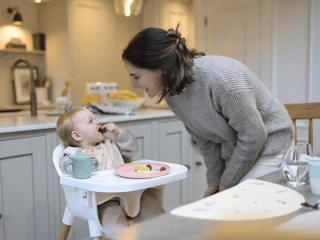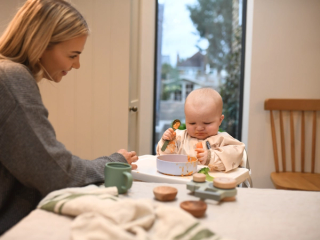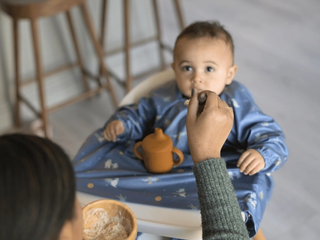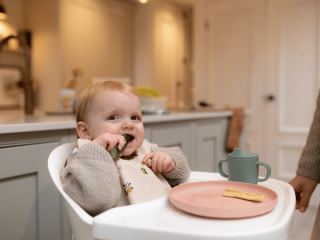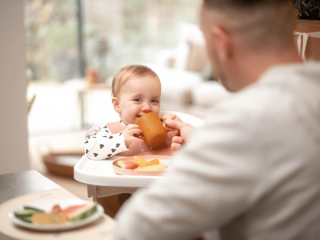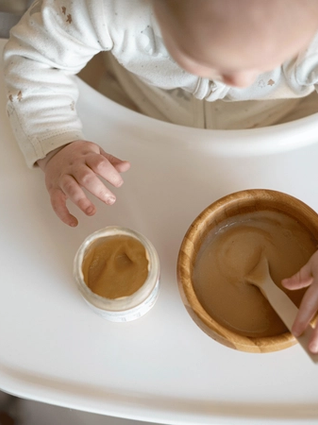
- Home
- Advice Hub
- Baby
- Weaning
- The Importance Of Single Flavours When Weaning
The importance of single flavours when weaning
When your baby is first given solid food there are lots of things to learn. Accepting and liking new flavours, how to move new textures around in the mouth, sitting in the highchair, understanding the dynamic of a family mealtimes and lots more!
First tastes
When your baby is first given solid food there are lots of things to learn. Accepting and liking new flavours, how to move new textures around in the mouth, sitting in the highchair, understanding the dynamic of family mealtimes, and lots more!
The food you give should always be nutritious. Babies only have small stomachs, so nutrient-rich foods are important right from the start. However, it’s also important to start discovering flavours and learning about tastes, so during the first couple of weeks it is good to concentrate on single flavours.
At birth, our sweet tastebuds are mature and start working straight away as breastmilk and formula are both sweet. We have an inbuilt preference for this type of flavour, which is why it’s a good idea to start weaning with bitter flavours so that babies can adjust to the big difference between the two tastes.
Some parents worry that their baby is going to get bored of single flavours. Don’t worry about that, there are lots of different options to explore and those first tastes are teaching your baby more than you might think. Each new food is an opportunity to experience something different; a new colour to look at, aroma to smell, flavour to taste , and texture to feel in the mouth.
You don’t need to give the same food day after day. Use a different food each day and start making a note of all the foods you’ve tried. The more variety you offer, the quicker your baby will learn to accept them. It is old advice that foods need to be given for three days in a row – this only applies to the main allergens. For vegetables and fruits, which are low allergen foods, you can give these freely and offer something different each day if you wish.
It’s all new!
Big changes in flavour are likely to be a new concept for your baby, and for some it can be quite an adjustment. Your baby will have experienced some different tastes, as Mum’s diet affects the taste of the amniotic fluid during pregnancy. If your baby was or is being breastfed the milk tastes varies with Mum’s diet; but formula has a very consistent flavour each time. Even with these slight changes over time, the big bold changes that come from eating actual food create a very different experience. Imagine having only ever tasted milk and then you put broccoli, salmon, yoghurt and other big flavours in your mouth. That’s why we often see LOTS of funny faces!
Research shows that the more times a baby is exposed to a particular flavour, the greater the chance that they’ll end up enjoying that food. So although we recommend changing up the foods you give each day, do make sure you’re going back and repeating foods as well.
You don’t need to sweeten
Over the years there has been a tendency to sweeten baby foods to increase enjoyment to encourage more to be eaten. For example, mixing fruit into vegetable purees or always giving flavoured yoghurts. However, we now know that it's better to help babies enjoy bitter flavours through constant exposure and not to worry about the volume eaten. It might not feel quite so rewarding to us as parents when our baby takes a little longer to enjoy some foods, but future you will be glad you persevered! Plus, there will always come a point where you stop sweetening and then what do you do? If your child has only ever eaten broccoli with pear they will find it a difficult flavour to adjust to when they are older.
Having a toddler who enjoys all foods is a much less stressful situation than one who has a sweet tooth and won’t touch a vegetable. (We should also point out, that fussy eating happens for lots of reasons, we can’t actually stop it, but we can help to minimise the impact of some aspects of it).
Remember: If your baby pulls faces when you give a food, it doesn’t mean they don’t like it. It might just be that it is a new flavour to become accustomed to. Many parents stop offering a food if their baby has pulled a face, but we recommend the opposite. If your baby pulls faces, keep offering. It can take several exposures for your baby to enjoy a flavour.
Finally; single flavours don’t have to be just a fruit or vegetable. You could offer foods like natural yoghurt (remember this is an allergen) or pureeed lentils too.
Advice & tips

Want to read more? Join the HiPP BabyClub for full access to this article.
As a BabyClub member, you'll get access to a range of exclusive benefits, including:
Monthly competitions
Discounts from our Partners
Expert advice tailored to your little one's age
Weaning recipes
HiPP shop discounts*
*10% off HiPP's online shop does not apply to our First Infant, Anti-Reflux or Comfort Formula Milk.
Important notice: Breastfeeding is best. Follow on milk should only be used as part of a mixed diet from 6 months. Talk to a healthcare professional.




